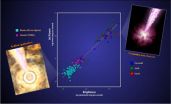(Press-News.org) Prostate cancer patients receiving the costly treatment known as proton radiotherapy experienced minimal relief from side effects such as incontinence and erectile dysfunction, compared to patients undergoing a standard radiation treatment called intensity modulated radiotherapy (IMRT), Yale School of Medicine researchers report in the Journal of the National Cancer Institute.
Standard treatments for men with prostate cancer, such as radical prostatectomy and IMRT, are known for causing adverse side effects such as incontinence and erectile dysfunction. Proponents of proton radiotherapy argue that the physical properties of protons may decrease these common side effects.
"Proton radiotherapy is increasing in popularity and more and more proton centers are being built throughout the country," said the study's lead author James Yu, M.D., assistant professor of therapeutic radiology at Yale Cancer Center and member of the Yale Cancer Outcomes, Public Policy, and Effectiveness Research (COPPER) Center at Yale. "However, there is a surprising lack of information about whether proton radiotherapy is actually superior to IMRT."
To find out, the Yale COPPER team studied a national sample of about 30,000 men with Medicare coverage who received treatment with either IMRT or proton radiotherapy for prostate cancer from 2008 to 2009. During this time, there were six centers offering proton radiotherapy in the United States and the authors found that some men travelled across the country for the treatment.
The team found that the incidence of complications such as problems with urinary function was slightly lower for proton radiotherapy at six months after treatment, but by 12 months after treatment there was no longer any difference. Despite the fact that there was no longer term benefit to the treatment in terms of side effects, Medicare paid over $32,000 per course of treatment, compared to less than $19,000 for a course of IMRT.
"We were surprised by these findings," said Cary Gross, senior author of the study and co-director of the COPPER Center. "Cancer centers are paying up to $100 million to build their own proton centers, and patients are travelling long distances to undergo proton therapy because the conventional wisdom has been that proton radiotherapy is better than IMRT. Our results suggest that this enthusiasm for proton therapy may be premature; it remains to be seen how proton radiotherapy will compare to IMRT at 10 or 15 years post-treatment."
###
Other authors on the study include Pamela Soulos, Jeph Herrin, Laura Cramer, Arnold Potosky, and Kenneth Roberts.
The study was funded by a grant from the National Cancer Institute (R01CA149045). Yu is also supported by the National Center for Research Resources (NCRR) and the National Center for Advancing Translational Science (NCATS), components of the National Institutes of Health (NIH), and NIH roadmap for medical research (KL2 RR024138).
Citation: JCNI: 10.1093/jnci/djs463
Despite hype, costly prostate cancer treatment offers little relief from side effects
2012-12-14
ELSE PRESS RELEASES FROM THIS DATE:
Tracing humanity's African ancestry may mean rewriting 'out of Africa' dates
2012-12-14
New research by a University of Alberta archeologist may lead to a rethinking of how, when and from where our ancestors left Africa.
U of A researcher and anthropology chair Pamela Willoughby's explorations in the Iringa region of southern Tanzania yielded fossils and other evidence that records the beginnings of our own species, Homo sapiens. Her research, recently published in the journal Quaternary International, may be key to answering questions about early human occupation and the migration out of Africa about 60,000 to 50,000 years ago, which led to modern humans ...
Better tools for saving water and keeping peaches healthy
2012-12-14
Peach growers in California may soon have better tools for saving water because of work by U.S. Department of Agriculture (USDA) scientists in Parlier, Calif.
Agricultural Research Service (ARS) scientist Dong Wang is evaluating whether infrared sensors and thermal technology can help peach growers decide precisely when to irrigate in California's San Joaquin Valley. ARS is USDA's principal intramural scientific research agency, and the research supports the USDA priority of promoting international food security.
Irrigation is the primary source of water for agriculture ...
Dark Ages scourge enlightens modern struggle between man and microbes
2012-12-14
The plague-causing bacteria Yersinia pestis evades detection and establishes a stronghold without setting off the body's early alarms.
New discoveries reported this week help explain how the stealthy agent of Black Death avoids tripping a self-destruct mechanism inside germ-destroying cells.
The authors of the study, appearing in the Dec. 13 issue of Cell Host & Microbe, are Dr. Christopher N. LaRock of the University of Washington Department of Microbiology and Dr. Brad Cookson, UW professor of microbiology and laboratory medicine.
Normally, certain defender cells ...
3 new species of venomous primate identified by MU researcher
2012-12-14
A venomous primate with two tongues would seem safe from the pet trade, but the big-eyed, teddy-bear face of the slow loris (Nycticebus sp.) has made them a target for illegal pet poachers throughout the animal's range in southeastern Asia and nearby islands. A University of Missouri doctoral student and her colleagues recently identified three new species of slow loris. The primates had originally been grouped with another species. Dividing the species into four distinct classes means the risk of extinction is greater than previously believed for the animals but could ...
Engineers roll up their sleeves -- and then do same with inductors
2012-12-14
CHAMPAIGN, Ill. — On the road to smaller, high-performance electronics, University of Illinois researchers have smoothed one speed bump by shrinking a key, yet notoriously large element of integrated circuits.
Three-dimensional rolled-up inductors have a footprint more than 100 times smaller without sacrificing performance. The researchers published their new design paradigm in the journal Nano Letters.
"It's a new concept for old technology," said team leader Xiuling Li, a professor of electrical and computer engineering at the University of Illinois.
Inductors, ...
Study reveals a remarkable symmetry in black hole jets
2012-12-14
Black holes range from modest objects formed when individual stars end their lives to behemoths billions of times more massive that rule the centers of galaxies. A new study using data from NASA's Swift satellite and Fermi Gamma-ray Space Telescope shows that high-speed jets launched from active black holes possess fundamental similarities regardless of mass, age or environment. The result provides a tantalizing hint that common physical processes are at work.
"What we're seeing is that once any black hole produces a jet, the same fixed fraction of energy generates the ...
NASA sees intensifying tropical cyclone moving over Samoan Islands
2012-12-14
VIDEO:
NASA's TRMM satellite passed above an intensifying Tropical Cyclone Evan on Dec. 11 at 1759 UTC (12:59 p.m. EST/U.S.) and saw the tallest thunderstorms around Evan's center of circulation reached...
Click here for more information.
NASA satellites have been monitoring Tropical Cyclone Evan and providing data to forecasters who expected the storm to intensify. On Dec. 13, Evan had grown from a tropical storm into a cyclone as NASA satellites observed cloud formation, ...
Rice uses light to remotely trigger biochemical reactions
2012-12-14
HOUSTON – (Dec. 13, 2012) – Since Edison's first bulb, heat has been a mostly undesirable byproduct of light. Now researchers at Rice University are turning light into heat at the point of need, on the nanoscale, to trigger biochemical reactions remotely on demand.
The method created by the Rice labs of Michael Wong, Ramon Gonzalez and Naomi Halas and reported today in the American Chemical Society journal ACS Nano makes use of materials derived from unique microbes – thermophiles – that thrive at high temperatures but shut down at room temperature.
The Rice project ...
Team solves mystery associated with DNA repair
2012-12-14
CHAMPAIGN, lll. — Every time a human or bacterial cell divides it first must copy its DNA. Specialized proteins unzip the intertwined DNA strands while others follow and build new strands, using the originals as templates. Whenever these proteins encounter a break – and there are many – they stop and retreat, allowing a new cast of molecular players to enter the scene.
Scientists have long sought to understand how one of these players, a repair protein known as RecA in bacterial cells, helps broken DNA find a way to bridge the gap. They knew that RecA guided a broken ...
More signs of the benefits of marriage?
2012-12-14
TORONTO, Dec. 13, 2012—There's new evidence about the benefits of marriage.
Women who are married suffer less partner abuse, substance abuse or post-partum depression around the time of pregnancy than women who are cohabitating or do not have a partner, a new study has found.
Unmarried women who lived with their partners for less than two years were more likely to experience at least one of the three problems. However, these problems became less frequent the longer the couple lived together.
The problems were most common among women who were separated or divorced, especially ...






